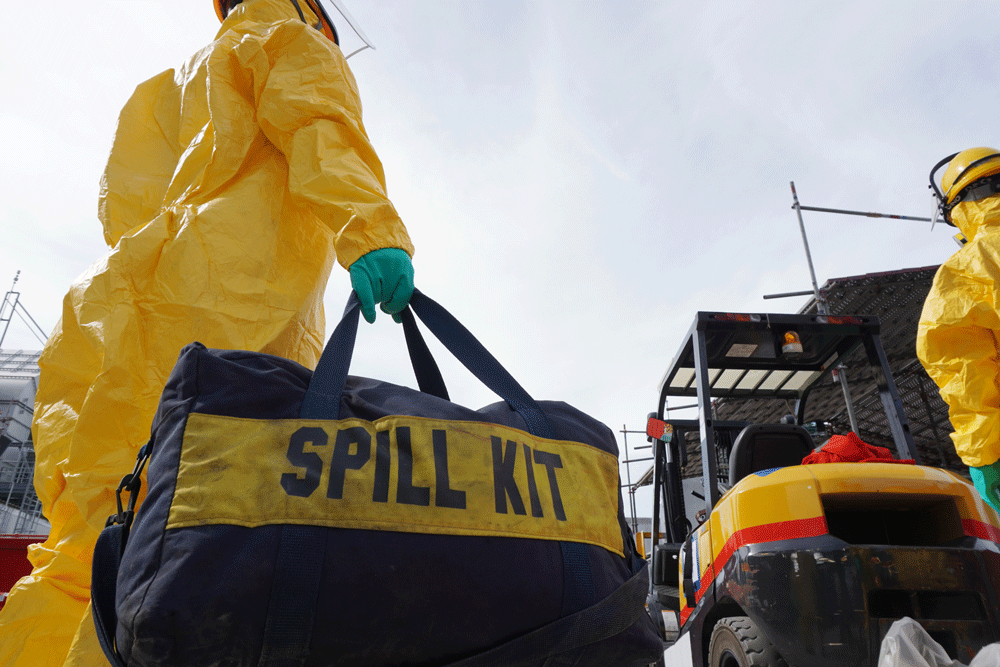How To Respond To A Chemical Spill
 CONTENTS
CONTENTS
- 1. Alert your staff and evacuate
- 2. Stop the spill
- 3. Contain the hazard
- 4. Clean up the spill
- Contact us today
One chemical spill can quickly shut down an entire facility and bring operations to a halt. Spills must be responded to promptly or they can damage your facility and the environment, and put your employees in harm’s way.
No matter the preventative measures you have in place, you should be prepared for accidents and have a chemical spill plan. The Heath and Safety Executive provides plenty of guidance to help you create a spill response plan for your business.
Here at ICE cleaning, we are chemical spill cleaning specialists, and have the experience and equipment to handle a spill of any size or severity. We operate 24/7, 365 days a year to get your business back up and running as soon as possible.
In this blog, we will go through the four steps required for every chemical spill response.
1. Alert your staff and evacuate
When you become aware of a chemical spill, you must alert supervisory personnel and staff about the hazard.
For major spills that are large or involve hazardous chemicals, you might also need to evacuate your co-workers, alert surrounding businesses, and notify the authorities immediately. They need to know which material was spilled and how much of it so they know how best to respond.
If a member of staff has been injured by the spill, contact the emergency services to get medical help. If safe to do so, remove them from the exposure area. While waiting for the emergency responders to arrive, flush contaminated areas with water if appropriate.
If it is not possible to remove them without exposing yourself to a dangerous situation, wait for the emergency services to arrive with the correct personal protective equipment so they can remove them safely.
2. Stop the spill
To stop a spill from getting worse, you must close valves or make sure the container that spilled is put upright, for example. Only a professional wearing the appropriate PPE should do this.
If there is a risk of fire or explosions, ignition sources, heat sources, or equipment that could create a fire hazard need to be turned off. Substances that could react with the spill must also be secured and put in a chemical segregation storage area. The relevant personnel in your workplace will handle this.
Then, ventilate the room or facility by opening up windows to prevent a build-up of fumes. However, if your facility is in an area with lots of passers-by that could be harmed by the fumes, keep the windows closed.
3. Contain the hazard
Depending on the chemical that has been spilled, you need to confine the spill with absorbent material or neutraliser. You will need a professional with the right equipment, gear, and experience to do this.
If the spill is spreading or at risk of going into a drain, they will use a drain plug, build a block with the material, or direct it elsewhere with a spill sock.
They will then block access to the spill by activating a containment barrier. If your facility does not have one, they will use caution tape and signs to stop co-workers from coming near or in contact with it.
You can use a chemical spill kit to handle and clean up chemicals. But it is recommended that you bring in professional cleaners to keep you and your staff safe, and guarantee a quick, effective response.
4. Clean up the spill
First, professional cleaners will collect the material they used to contain and neutralise the spill and dispose of it in the appropriate way. Small spills might require a plastic bag, but larger spills involving more dangerous chemicals might require plastic pails or drums.
The equipment they used to clean up the spill, like brooms or dustpans, might qualify as a hazardous material. They will need to be labelled and disposed of according to local regulations.
Finally, they will clean the surfaces affected by the spill with the appropriate material, such as bleach or water.
If you or your co-workers were contaminated by the chemicals, you must wash your hands and any other areas. If they can be safely decontaminated, wash your clothes, or else dispose of them in a safe way.
At ICE Cleaning, our technicians are certified to handle and dispose of all types of biohazardous waste, including dangerous chemicals. This includes mercury cleaning, bromine cleaning, and hazardous waste clean-up.
Contact us today
Get in touch with our team on 0208 066 0360 or at enquiries@icecleaning.co.uk to book our specialist technicians for chemical spill cleaning. Our team can provide a free survey for your spill and no-obligation quote for our services.

Speak with me today,
I’m here to help
By asking you a few questions either via phone or email I can immediately provide a realistic estimation of the cost.
You’re in good company. We’ve cleaned for the following commercial clients… View all

Why choose us?
- Cater to a wide variety of cleaning situations
- Nationwide coverage, available 24/7
- Cater to commercial and domestic clients
- Free survey provided prior to quotation
- Emergency response team
- Offer a bespoke service designed to suit all your needs
- All technicians hold professional health and safety qualifications, including BICSc, IOSH, Dewpoint Professional & Safe Contractor
We’re fully accredited
We place best practise, professional expertise and health and safety at the core of our business. We’re fully compliant with all legal obligations. You can view a list of our accreditations below, or visit our Health & Safety page for more information.











-RGB-small.1707319151.jpg)




















